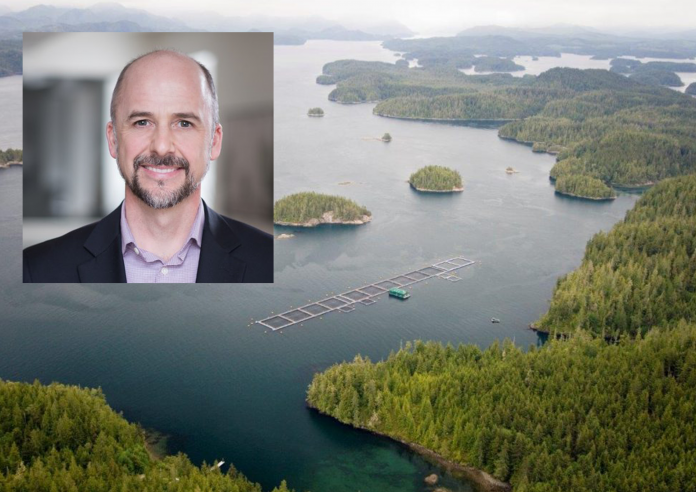Farmed salmon continues to be B.C.’s most valuable seafood export by far, so what’s with the move to land-based? The head of the Canadian Aquaculture Industry Alliance says it needs to do a better job at communicating what it is doing right.
Over the past year, British Columbia salmon farming, in particular, has taken a bruising. Wild salmon corridors and with it the loss of leases, and now the government is mulling moving the country’s single largest agricultural export to land-based.
Timothy J. Kennedy President & CEO of the Canadian Aquaculture Industry Alliance – the national association that speaks for Canada’s seafood farmers – spoke frankly to SalmonBusiness about the issues the BC salmon farming industry face.

Report
A few days ago, Fisheries and Oceans Canada (DFO) released a 64 report looking at the feasibility of salmon aquaculture technology in British Columbia, Canada. Bear in mind that currently, 94% of the regions salmon total comes from traditional open-net sea pens.
“Marine farming is the most significant food solution for carbon emission reductions going forward,” said Kennedy. “I ask the environmental critics how they square this stuff – there are minimal impacts to marine salmon farming and yet we know there are more significant impacts on the land farming side,” said Kennedy.
In regards to Minister of Fisheries, Oceans and the Canadian Coast Guard Bernadette Jordan mandate to come up with a plan (and not to necessarily completely) to phase out open-net aquaculture in B.C by 2025, Kennedy said explained that this was problematic.
“The plan is by 2025. And there is a minority parliament – which means that it could be a 2-3 year parliament before another election,” he said.
- Read more: “They are listening”: Industry meet Minister of Fisheries to discuss future of BC salmon farming

How does it make the industry feel, that authorities are even mulling a move to land-based?
“As you can imagine, it’s incredibly frustrating – the biggest challenge is between the gulf between the unbelievable opportunity in Canada (both BC and the East Coast) and Ontario for instance. The propagation of old information that just doesn’t have a bearing on practices today. Critics will do what they do and BC is a very critic heavy part of the world. But it’s our job to continue to make our case – and we have to do a better job at that, that’s up to us.”
“I think, our primary task is to work with the DFO and the Canadian government to further clarify where things are going. The big reason for that is that the investment cycle is about 7-10 years, people are making the investment for down the road. The really difficult and unfortunate part of what we are dealing with now is that I think all the companies in BC are wanting to truly unleash some amazing sustainable technology – such as semi-closed containment, new treatments.”
Uncertainty
Though Kennedy said that with all the upcoming uncertainty, it’s realistic to think that some of it may not happen. “Companies have that long term investment framework and yet we are looking at this challenge right now,” he said, adding that many of the federal licences and provincial tenures are up for grabs in 2022.
How does one go about doing a better job?
Kennedy explained that in BC, the industry works with 15 indigenous partners, and that needed to be explained more. “In each household, at least one person in those communities works for a salmon farmer – this is really the future for these communities”.
He also talked about the impact of a bitter 8-month Vancouver Island forestry strike (that industry is effectively on hold), coupled with a tiny tourism industry and dwindling wild fish stocks, on jobs.

“Commercial fishing has also been declining (…) but salmon has been overfished and, of course, everyone blames us for that. But the decline of salmon has much bigger reasons to be concerned about. Chum has had some strong returns but sockeye and some other species have not returned to the extent that they’d hoped.”
‘These remote communities have depended on resources and mainly forestry in BC – that sector is really hurting right now I truly believe salmon is the single largest opportunity for small and medium-sized communities across Canada,” he said.
“Dirty salmon producers”
Kennedy said that was an opportunity for salmon farmers to help transfer some of their techs to wild fish hatcheries.
“Hatcheries are privately run and also by DFO and they are not efficient. Mortality rates are very high, our production in our hatcheries are much more efficient. There seems to be a real barrier between collaboration – and that should fold because we should be working together on improving wild hatcheries. We could unleash a certain level of technology to help wild capture. It’s unfortunate that it’s more activist driven, so they think “ no we can’t have those so-called dirty salmon producers” helping us”.











